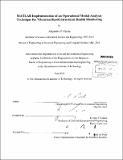MATLAB implementation of an operational modal analysis technique for vibration-based structural health monitoring
Author(s)
Ojeda, Alejandro P
DownloadFull printable version (6.625Mb)
Other Contributors
Massachusetts Institute of Technology. Dept. of Civil and Environmental Engineering.
Advisor
Jerome J. Connor.
Terms of use
Metadata
Show full item recordAbstract
Vibration-based structural health monitoring (SHM) has become an attractive solution for the global monitoring and evaluation of damage in structures. Numerous damage detection schemes used in vibration-based SHM require knowledge of the modal properties of the structure under evaluation in its current state. The technique of operational modal analysis allows for these modal properties to be obtained by using the structure's dynamic response to ambient excitation. Using MATLAB, a type of operational modal analysis technique called time domain decomposition (TDD) based on [15] was implemented. The MATLAB TDD implementation was applied to the dynamic responses from two finite element models of simply-supported beams and their modal frequencies and shapes were extracted. The first three modal frequencies were obtained with less than 6 percent error from the actual values and the fundamental mode shape values obtained contained negligible deviations from the actual mode shape values. However, the higher order mode shapes obtained were more inaccurate, suggesting limitations to the current MATLAB TDD implementation. Lastly, changes to the moment of inertia of the simply-supported beam models were used to simulate damage in the finite element models and cause their fundamental mode frequency to change. The MATLAB TDD implementation was able to distinguish changes in the fundamental frequency of both finite element models with a resolution of approximately 1.7 radians per second (7.2 percent).
Description
Thesis (M. Eng.)--Massachusetts Institute of Technology, Dept. of Civil and Environmental Engineering, 2012. Cataloged from PDF version of thesis. Includes bibliographical references (p. 72-73).
Date issued
2012Department
Massachusetts Institute of Technology. Department of Civil and Environmental EngineeringPublisher
Massachusetts Institute of Technology
Keywords
Civil and Environmental Engineering.